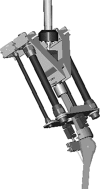Effects of a contoured articular prosthetic device on tibiofemoral peak contact pressure: a biomechanical study
- PMID: 17934718
- PMCID: PMC2190783
- DOI: 10.1007/s00167-007-0416-7
Effects of a contoured articular prosthetic device on tibiofemoral peak contact pressure: a biomechanical study
Abstract
Many middle-aged patients are affected by localized cartilage defects that are neither appropriate for primary, nor repeat biological repair methods, nor for conventional arthroplasty. This in vitro study aims to determine the peak contact pressure in the tibiofemoral joint with a partial femoral resurfacing device (HemiCAP, Arthrosurface Inc., Franklin, MA, USA). Peak contact pressure was determined in eight fresh-frozen cadaveric specimens using a Tekscan sensor placed in the medial compartment above the menisci. A closed loop robotic knee simulator was used to test each knee in static stance positions (5 degrees /15 degrees /30 degrees /45 degrees ) with body weight ground reaction force (GRF), 30 degrees flexion with twice the body weight (2tBW) GRF and dynamic knee-bending cycles with body weight GRF. The ground reaction force was adjusted to the living body weight of the cadaver donor and maintained throughout all cycles. Each specimen was tested under four different conditions: Untreated, flush HemiCAP implantation, 1-mm proud implantation and 20-mm defect. A paired sampled t test to compare means (significance, P < or = 0.05) was used for statistical analysis. On average, no statistically significant differences were found in any testing condition comparing the normal knee with flush device implantation. With the 1-mm proud implant, statistically significant increase of peak contact pressures of 217% (5 degrees stance), 99% (dynamic knee bending) and 90% (30 degrees stance with 2tBW) compared to the untreated condition was seen. No significant increase of peak contact pressure was evaluated with the 20-mm defect. The data suggests that resurfacing with the HemiCAP does not lead to increased peak contact pressure with flush implantation. However, elevated implantation results in increased peak contact pressure and might be biomechanically disadvantageous in an in vivo application.
Figures





Similar articles
-
Tibiofemoral contact mechanics with a femoral resurfacing prosthesis and a non-functional meniscus.Clin Biomech (Bristol). 2009 Oct;24(8):648-54. doi: 10.1016/j.clinbiomech.2009.05.013. Epub 2009 Jun 26. Clin Biomech (Bristol). 2009. PMID: 19560241
-
Effects of a surface matching articular resurfacing device on tibiofemoral contact pressure: results from continuous dynamic flexion-extension cycles.Arch Orthop Trauma Surg. 2011 Mar;131(3):413-9. doi: 10.1007/s00402-010-1201-5. Epub 2010 Oct 22. Arch Orthop Trauma Surg. 2011. PMID: 20967546
-
Femorotibial kinematics and load patterns after total knee arthroplasty: An in vitro comparison of posterior-stabilized versus medial-stabilized design.Clin Biomech (Bristol). 2016 Mar;33:42-48. doi: 10.1016/j.clinbiomech.2016.02.002. Epub 2016 Feb 17. Clin Biomech (Bristol). 2016. PMID: 26945720
-
Patellar resurfacing has minimal impact on in vitro tibiofemoral kinematics during deep knee flexion in total knee arthroplasty.Knee. 2021 Jun;30:163-169. doi: 10.1016/j.knee.2021.04.001. Epub 2021 Apr 28. Knee. 2021. PMID: 33932828
-
The partial femoral condyle focal resurfacing (HemiCAP-UniCAP) for treatment of full-thickness cartilage defects, systematic review and meta-analysis.Acta Orthop Belg. 2021 Mar;87(1):93-102. Acta Orthop Belg. 2021. PMID: 34129762
Cited by
-
Cartilage defect location and stiffness predispose the tibiofemoral joint to aberrant loading conditions during stance phase of gait.PLoS One. 2018 Oct 16;13(10):e0205842. doi: 10.1371/journal.pone.0205842. eCollection 2018. PLoS One. 2018. PMID: 30325946 Free PMC article.
-
Radial Tears of the Lateral Meniscus-Two Novel Repair Techniques: A Biomechanical Study.Orthop J Sports Med. 2018 Apr 27;6(4):2325967118768086. doi: 10.1177/2325967118768086. eCollection 2018 Apr. Orthop J Sports Med. 2018. PMID: 29780840 Free PMC article.
-
Good subjective outcome and low risk of revision surgery with a novel customized metal implant for focal femoral chondral lesions at a follow-up after a minimum of 5 years.Arch Orthop Trauma Surg. 2022 Oct;142(10):2887-2892. doi: 10.1007/s00402-021-04160-z. Epub 2021 Sep 14. Arch Orthop Trauma Surg. 2022. PMID: 34523047 Free PMC article.
-
Prosthetic inlay resurfacing for the treatment of focal, full thickness cartilage defects of the femoral condyle: a bridge between biologics and conventional arthroplasty.Knee Surg Sports Traumatol Arthrosc. 2012 Sep;20(9):1753-9. doi: 10.1007/s00167-011-1757-9. Epub 2011 Nov 11. Knee Surg Sports Traumatol Arthrosc. 2012. PMID: 22076054
-
Biomechanical considerations in the pathogenesis of osteoarthritis of the knee.Knee Surg Sports Traumatol Arthrosc. 2012 Mar;20(3):423-35. doi: 10.1007/s00167-011-1818-0. Epub 2011 Dec 16. Knee Surg Sports Traumatol Arthrosc. 2012. PMID: 22173730 Free PMC article.
References
-
- {'text': '', 'ref_index': 1, 'ids': [{'type': 'DOI', 'value': '10.1177/0363546505278300', 'is_inner': False, 'url': 'https://doi.org/10.1177/0363546505278300'}, {'type': 'PubMed', 'value': '16093531', 'is_inner': True, 'url': 'https://pubmed.ncbi.nlm.nih.gov/16093531/'}]}
- Beck PR, Thomas AL, Farr J, Lewis PB, Cole BJ (2005) Trochlear contact pressures after anteromedialization of the tibial tubercle. Am J Sports Med 33:1710–1715 - PubMed
-
- {'text': '', 'ref_index': 1, 'ids': [{'type': 'PMC', 'value': 'PMC1888787', 'is_inner': False, 'url': 'https://pmc.ncbi.nlm.nih.gov/articles/PMC1888787/'}, {'type': 'PubMed', 'value': '16089079', 'is_inner': True, 'url': 'https://pubmed.ncbi.nlm.nih.gov/16089079/'}]}
- Brand RA (2005) Joint contact stress: a reasonable surrogate for biological processes? Iowa Orthop J 25:82–94 - PMC - PubMed
-
- {'text': '', 'ref_index': 1, 'ids': [{'type': 'DOI', 'value': '10.1056/NEJM199410063311401', 'is_inner': False, 'url': 'https://doi.org/10.1056/nejm199410063311401'}, {'type': 'PubMed', 'value': '8078550', 'is_inner': True, 'url': 'https://pubmed.ncbi.nlm.nih.gov/8078550/'}]}
- Brittberg M, Lindahl A, Nilsson A, Ohlsson C, Isaksson O, Peterson L (1994) Treatment of deep cartilage defects in the knee with autologous chondrocyte transplantation. N Engl J Med 331:889–895 - PubMed
-
- {'text': '', 'ref_index': 1, 'ids': [{'type': 'DOI', 'value': '10.1002/jor.1100090412', 'is_inner': False, 'url': 'https://doi.org/10.1002/jor.1100090412'}, {'type': 'PubMed', 'value': '2045983', 'is_inner': True, 'url': 'https://pubmed.ncbi.nlm.nih.gov/2045983/'}]}
- Brown TD, Pope DF, Hale JE, Buckwalter JA, Brand RA (1991) Effects of osteochondral defect size on cartilage contact stress. J Orthop Res 9:559–567 - PubMed
-
- {'text': '', 'ref_index': 1, 'ids': [{'type': 'DOI', 'value': '10.1097/00003086-197201000-00033', 'is_inner': False, 'url': 'https://doi.org/10.1097/00003086-197201000-00033'}, {'type': 'PubMed', 'value': '5011034', 'is_inner': True, 'url': 'https://pubmed.ncbi.nlm.nih.gov/5011034/'}]}
- Convery FR, Akeson WH, Keown GH (1972) The repair of large osteochondral defects. An experimental study in horses. Clin Orthop Relat Res 82:253–262 - PubMed
MeSH terms
LinkOut - more resources
Full Text Sources
Other Literature Sources
Medical

